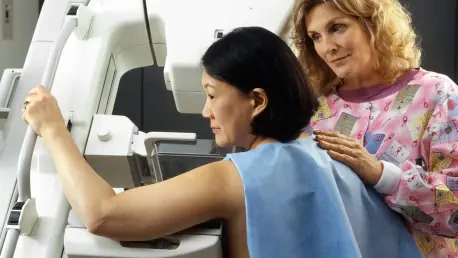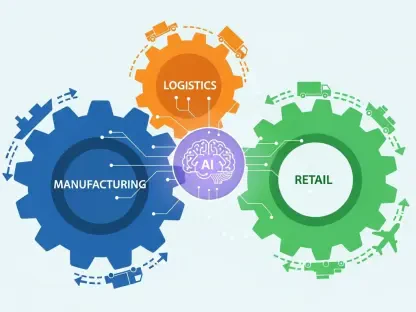Pioneering a New Frontier in Breast Cancer Detection
Imagine a world where breast cancer risk can be predicted with unprecedented accuracy, enabling early interventions that save countless lives, and this vision is becoming reality with the recent FDA Breakthrough Device designation awarded to Prognosia Breast. This AI-based software is transforming the landscape of breast cancer screening, developed through cutting-edge research at Washington University School of Medicine in St. Louis and licensed to Prognosia Inc., by analyzing mammogram images to deliver personalized five-year risk scores. As breast cancer remains a leading health concern affecting millions globally, the emergence of such technology signals a pivotal shift in medical diagnostics. This market analysis delves into the implications of this innovation, exploring current trends in AI-driven healthcare, forecasting its impact on the breast cancer screening market, and highlighting strategic opportunities for stakeholders in this rapidly evolving sector.
Market Dynamics and Emerging Trends in AI Healthcare
Surging Adoption of AI in Medical Diagnostics
The healthcare industry is witnessing a seismic shift with the integration of artificial intelligence into diagnostic tools, particularly in oncology. AI technologies are increasingly being leveraged to enhance precision in disease prediction, with breast cancer screening emerging as a key focus area. Prognosia Breast exemplifies this trend, offering a risk prediction model that boasts 2.2 times greater accuracy than traditional questionnaire-based methods. This precision stems from machine learning algorithms trained on vast datasets of mammogram images, identifying subtle risk indicators invisible to the human eye. As of now, with over 75% of women aged 50 to 74 in the U.S. undergoing regular mammograms, the market is ripe for such innovations to penetrate existing screening infrastructures, potentially reshaping patient outcomes on a massive scale.
Regulatory Acceleration and Market Entry
A significant driver of market growth for AI-based medical tools is the regulatory support exemplified by the FDA’s Breakthrough Device designation. Awarded to Prognosia Breast on July 29 of this year, this status fast-tracks the path to full market approval, reflecting the urgency to address life-threatening conditions through advanced diagnostics. This designation not only validates the technology’s potential but also signals to investors and healthcare providers that AI tools are poised for rapid integration into clinical settings. However, challenges persist in ensuring post-approval monitoring to confirm long-term efficacy across diverse populations. The regulatory landscape is thus a double-edged sword, balancing accelerated access with the need for rigorous validation to maintain trust and safety in medical markets.
Accessibility and Scalability in Diverse Markets
Another critical trend shaping the market is the focus on accessibility and scalability of AI diagnostic tools. Prognosia Breast stands out for its compatibility with both 2D full-field digital mammography and 3D synthetic views from digital breast tomosynthesis, allowing seamless integration into existing global mammography systems. This adaptability addresses a major barrier to adoption, as it eliminates the need for costly equipment upgrades. Yet, disparities in access to mammography services, particularly in underserved regions, pose a hurdle to equitable deployment. Market players must strategize to pair such technologies with initiatives like mobile screening units to ensure broader reach, tapping into untapped segments and fostering inclusivity in breast cancer care.
Future Projections for AI in Breast Cancer Screening
Growth Potential and Market Expansion
Looking ahead, the market for AI-driven breast cancer risk assessment tools is projected to expand significantly from this year to 2027, driven by rising demand for personalized medicine and early detection solutions. With the ability to reduce late-stage diagnoses—currently affecting about 34% of U.S. patients—tools like Prognosia Breast could capture a substantial share of the diagnostic imaging market. Analysts anticipate that as clinical trials validate the software’s efficacy, adoption rates will surge, especially in developed markets with established screening programs. Emerging economies also present growth opportunities, provided that partnerships with local healthcare providers and governments address infrastructure gaps, positioning AI as a cornerstone of preventive care worldwide.
Technological Advancements on the Horizon
Innovation in AI diagnostics is expected to accelerate, with future iterations of tools like Prognosia Breast potentially analyzing longitudinal mammogram data from individual patients to refine risk predictions further. Integration with complementary technologies, such as wearable health monitors, could enable real-time risk updates, creating a more dynamic approach to breast cancer prevention. However, market growth hinges on overcoming technical challenges, such as ensuring consistent accuracy across varied imaging qualities and diverse patient demographics. Investment in research and development will be crucial to sustain momentum, as will collaboration between tech developers and healthcare institutions to pilot and scale these advancements effectively.
Economic and Policy Influences
Economic factors, including reimbursement policies for AI-based diagnostics, will play a pivotal role in shaping market trajectories. As payers and insurers evaluate the cost-effectiveness of integrating such tools into standard care, clear evidence of reduced healthcare costs through early intervention will be essential. Policy frameworks are also evolving to support AI adoption, with incentives for hospitals to implement cutting-edge technologies likely to emerge. Yet, uncertainties around data privacy and ethical use of AI in healthcare could temper growth if not addressed through robust governance. Stakeholders must navigate these complexities to unlock the full economic potential of AI in transforming breast cancer screening markets.
Reflecting on Market Shifts and Strategic Pathways
Reflecting on the insights gained, the journey of Prognosia Breast underscores a transformative period in the breast cancer screening market, where AI emerges as a powerful ally in early detection and risk assessment. Its FDA Breakthrough Device designation marks a significant milestone, affirming the technology’s potential to redefine clinical practices. The market analysis reveals a clear trajectory of growth, driven by technological innovation, regulatory support, and a pressing need for precision in diagnostics. For stakeholders, the path forward involves strategic investments in scalability, ensuring equitable access across global markets, and advocating for policies that support reimbursement and ethical AI use. Collaborations between tech developers, healthcare providers, and policymakers become essential to bridge access gaps and integrate such tools into routine care. Ultimately, the focus shifts to empowering clinicians and patients with data-driven solutions, setting a precedent for how innovation can outpace disease in the fight against breast cancer.









